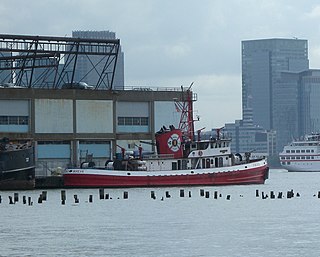
Duwamish was one of the most powerful fireboats in the United States several times over her 75-year working life. She is the second oldest vessel designed to fight fires in the US, after Edward M. Cotter, in Buffalo, New York.

A fireboat is a specialized watercraft with pumps and nozzles designed for fighting shoreline and shipboard fires. The first fireboats, dating to the late 18th century, were tugboats, retrofitted with firefighting equipment. Older designs derived from tugboats and modern fireboats more closely resembling seafaring ships can both be found in service today. Some departments would give their multi-purpose craft the title of "fireboat" also.

Toronto Fire Services (TFS) provides fire protection, technical rescue services, hazardous materials response, and first responder emergency medical assistance in Toronto, Ontario, Canada. Toronto Fire Services is currently the largest municipal fire department in Canada.

Edward M. Cotter is a fireboat in use by the Buffalo Fire Department at Buffalo, New York, United States. Originally named William S. Grattan, it was built in 1900 by the Crescent Shipyard of Elizabeth Port, New Jersey. Due to age, it was rebuilt in 1953 and renamed Firefighter upon its return to service. The following year it was renamed Edward M. Cotter. its namesake, Edward Cotter, was a Buffalo firefighter and leader of the local firefighters union who had recently died.

Ralph J. Scott, also formerly known as Fireboat #2, is a 100-foot (30 m) fireboat that was attached to the Los Angeles Fire Department serving the Port of Los Angeles. She was retired in 2003 after 78 years and replaced by Warner L. Lawrence. Ralph J. Scott is on display near the Los Angeles Maritime Museum in San Pedro. On 30 June 1989, she was listed as a National Historic Landmark. She is currently located at the Los Angeles Fire Department, Fire Station 112, at 444 South Harbor Blvd, Berth 86, San Pedro, California, 90731

Fire Fighter is a fireboat which served the New York City Fire Department from 1938 through 2010, serving with Marine Companies 1, 8 and 9 during her career. The most powerful diesel-electric fireboat in terms of pumping capacity when built in 1938, Fire Fighter fought more than 50 major fires during her career, including fires aboard the SS Normandie in 1942 and the SS El Estero in 1944, the 1973 collision of the Esso Brussels and SS Sea Witch, and the terrorist attacks on September 11, 2001.

John D. McKean is a fireboat that served the New York City Fire Department as Marine Company 1. She is named after John D. Mckean, who died in a 1953 steam explosion while trying to save a predecessor fireboat, the George B. McClellan.

The John H. Glenn Jr. is a fireboat stationed on the Potomac and Anacostia rivers in Washington, D.C. Her bow was reinforced in 1984, and allows her to also serve as an icebreaker during the winter.

The Christopher Wheatley is a fireboat delivered to the Chicago Fire Department in 2011. When she was delivered in April 2011, she was the first new fireboat to serve the city in sixty years. She replaced the Victor L. Schlaeger.

As an important port city, Chicago has operated dedicated fireboats since 1877.
Deluge was a fireboat built for the Milwaukee, Wisconsin fire department. She was christened on 1 April 1949. According to The Milwaukee Journal, "Deluge will be the most modern and one of the most powerful fire fighting craft west of New York city."'
The Geyser was a steam powered fireboat built for Chicago, Illinois in 1886. Chicago had operated three earlier vessels, as fireboats, but they had all been retrofits. The Geyser was specifically designed as a fireboat, after Fire Marshall Denis J. Swenie visited eastern cities to learn from their purpose-built fireboats.

The fireboat Joseph Medill was commissioned in Chicago, Illinois, in 1908, and was the first of two Chicago fireboats of that name—the second being commissioned in 1949. When she was commissioned she joined five other fireboats.
The Illinois was a fireboat operated by the Chicago Fire Department. She was commissioned in 1888, and she was then described as the most powerful fireboat afloat. She was one of the first fireboats to have a steel hull at a time when other fireboats were built of wood.
As a major port a number of fireboats of San Francisco have been operated by the city of San Francisco since 1878.

The John Kendall was a steam-powered fireboat launched in 1929 by the Toledo Shipbuilding Company and operated by the Detroit Fire Department from 1930 to 1976. During her service as a fireboat she continued to be propelled by steam engines, requiring a crew of ten, five of whom were required to stoke her boiler. She was converted to a tugboat, and her steam engines were finally replaced by diesel engines. She served an additional 20 years as a tug, out of Alpena, Michigan. She was scrapped in 1994.

Fireboats in San Diego have been operated on San Diego Bay by the city of San Diego, California since the early 20th century, as well as by the Port of San Diego since its creation as a quasi-governmental agency serving the entire Bay in 1962.

The Abram S. Hewitt was a coal-powered fireboat operated by the Fire Department of New York City from 1903 to 1958. She was the department's last coal-powered vessel and had a pumping capacity of 7,000 gallons per minute.
The Portland Fire Bureau of the city of Portland, Oregon owns and operates Fireboats in Portland, Oregon.
The Philadelphia Fire Department started operating the fireboat Independence in 2007. The vessel cost $5 million, $4.5 million of which came from a FEMA Port Security Grant.














